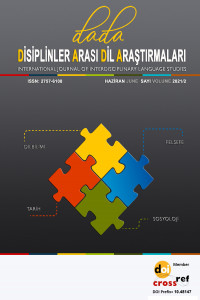Öz
Diller arasındaki farklılık ve benzerlikler, tipoloji başlığı
altında ele alınan ve oldukça ayrıntılı çalışılan/çalışılması
gereken dilbilim çalışma konularıdır. Diller; sesbilim,
biçimbilim ve sözdizim bakımından yapısal benzerlik ve
farklılıklar içermektedir. Bu benzerlik ve farklılıklar dil
öğretim veya öğrenim süreçlerinde belirleyicidir. Diller
arasındaki –özellikle- yapısal benzerlikler dil öğrenicileri
tarafından hedef dilin öğrenimini kolaylaştırırken
farklılıkların fazla oluşu bu öğrenim sürecini uzatmakta ve
daha zor bir hâl almasına sebep olabilmektedir. Bu durumun
aksi örnekleri de olabilir. İkinci dil olarak öğrenilmeye
çalışılan bir dille daha önce başka dillerin üzerine
öğrenilmeye çalışılan dillerde bu öğrenim süreci farklı
işlemektedir. D1 ve D2 olarak ifade edilen D1 birinci dili
(ana dili), D2 ise öğrenilmek istenilen dili yani hedef dili
ifade etmektedir. Bu çalışmada D1 Endonezyaca (Bahasa
Endonezyaca) olan ve yaşları 19-21 arasında değişen 5 kadın,
5 erkek konuşurun Türkçe ünlü üretimleri incelenmiştir. Bu
inceleme R programlama dili ile gösterilmiştir. Buna göre
çıkan sonuçlar çalışmanın bulgu ve sonuç bölümlerinde
ayrıntılı bir biçimde açıklanmıştır.
Anahtar Kelimeler
Endonezyaca sesbilim sesbilimsel tipoloji ünlüler R programlama
Kaynakça
- Alwi, Hasan ve Dardjowidjojo, Soenjona ve Lapoliwa, Hans ve Moeliono, Anton M (1998). Tata Bahasa Baku Bahasa Indonesia: Edisi Ketiga. Jakarta: Balai Pustaka
- Best, Catherine ve Tyler, Michael Douglas (2007) “Nonnative and secondlanguage speech perception.” In O.-S. Bohn and M. J. Munro (eds.) Language Experience in Second Language Speech Learning: In Honor of James Emil Flege, 13–34.
- Boersma, Paul ve Weenink, David (2020). Praat: Doing Phonetics by Computer. 6.1.09 sürüm.
- Catford, John Cunnison (1988). A Practical Introduction to Phonetics. UK: Oxford University Press.
- Common European Framework of Reference for Languages: Learning, Teaching,Assessment (CEFR).
- Core, R. Team (2014). R: A language and environment for statiscal computing. R Foundation for Statiscal Computing. Austria. URL http://www.R-project.org/.
- Crystal, David (2008). A Dictionary of Linguistics and Phonetics. USA: Blackwell Pub.
- Flege, James (1995) “Second language speech learning: Theory, findings, and problems.” In W. Strange (ed.) Speech Perception and Linguistic Experience: Issues in Cross- Language Research, 233– 277. Timonium, MD: York Press.
- Kent, Raymond D. ve Read, Charles (2001). The Acoustic Analysis of Speech. Singular/Thomson Learning Yay.
- Lobanov, B. M. (1971). Classification of Russian vowels spoken by different speakers. Journal of The Acoustical Society of America 49, 606-608.
- Maddieson, Ian (2013b). Vowel quality inventories. M.S. Dryer and M. Haspelmath (Haz.), The World atlas of Language Structures Online içinde. Almanya: MAx-Planck-Institut für evolutionare Anthropologie.
- Sneddon, James (2008). Indonesian Reference Grammar. Sydney: Allen & Unwin Pub.
- Tadmor, Uri (2018). "Malay-Indonesian". İçinde Bernard Comrie (ed.). The World's Major Languages. Routledge. s. 810-815.
Öz
Differences and similarities between languages are the
subjects of linguistics that are discussed under the title of
typology and should be studied in seriously. Languages;
contains structural similarities and differences in terms of
phonology, morphology and syntax. These similarities and
differences are determinative in language teaching or
learning processes. While the structural similarities between
languages - especially - facilitate the learning of the target
language by language learners, the large number of
differences comlicate the learning process and make it more
difficult. There are also some opposite cases for this situation.
This learning process works differently with a language that
is tried to be learned as a second language and languages that
have been tried to be learned on other languages before. D1
refers to the first language (mother tongue), and D2 refers to
the language to be learned, or the target language. In this
study, 19-21 ages, D1 Indonesian (Bahasa Indonesian)
speaker 5 females and 5 males Turkish vowel productions
were analyzed. This study was illustrated by the R Package
language. Accordingly, the results are explained in detail in
the findings and conclusion sections of the study.
Anahtar Kelimeler
Indonesian phonology phonoligical typologies vowels R packages
Kaynakça
- Alwi, Hasan ve Dardjowidjojo, Soenjona ve Lapoliwa, Hans ve Moeliono, Anton M (1998). Tata Bahasa Baku Bahasa Indonesia: Edisi Ketiga. Jakarta: Balai Pustaka
- Best, Catherine ve Tyler, Michael Douglas (2007) “Nonnative and secondlanguage speech perception.” In O.-S. Bohn and M. J. Munro (eds.) Language Experience in Second Language Speech Learning: In Honor of James Emil Flege, 13–34.
- Boersma, Paul ve Weenink, David (2020). Praat: Doing Phonetics by Computer. 6.1.09 sürüm.
- Catford, John Cunnison (1988). A Practical Introduction to Phonetics. UK: Oxford University Press.
- Common European Framework of Reference for Languages: Learning, Teaching,Assessment (CEFR).
- Core, R. Team (2014). R: A language and environment for statiscal computing. R Foundation for Statiscal Computing. Austria. URL http://www.R-project.org/.
- Crystal, David (2008). A Dictionary of Linguistics and Phonetics. USA: Blackwell Pub.
- Flege, James (1995) “Second language speech learning: Theory, findings, and problems.” In W. Strange (ed.) Speech Perception and Linguistic Experience: Issues in Cross- Language Research, 233– 277. Timonium, MD: York Press.
- Kent, Raymond D. ve Read, Charles (2001). The Acoustic Analysis of Speech. Singular/Thomson Learning Yay.
- Lobanov, B. M. (1971). Classification of Russian vowels spoken by different speakers. Journal of The Acoustical Society of America 49, 606-608.
- Maddieson, Ian (2013b). Vowel quality inventories. M.S. Dryer and M. Haspelmath (Haz.), The World atlas of Language Structures Online içinde. Almanya: MAx-Planck-Institut für evolutionare Anthropologie.
- Sneddon, James (2008). Indonesian Reference Grammar. Sydney: Allen & Unwin Pub.
- Tadmor, Uri (2018). "Malay-Indonesian". İçinde Bernard Comrie (ed.). The World's Major Languages. Routledge. s. 810-815.
Ayrıntılar
| Birincil Dil | Türkçe |
|---|---|
| Konular | Dil Çalışmaları |
| Bölüm | Araştırma Makaleleri |
| Yazarlar | |
| Erken Görünüm Tarihi | 1 Nisan 2022 |
| Yayımlanma Tarihi | 15 Haziran 2021 |
| Gönderilme Tarihi | 15 Mayıs 2021 |
| Yayımlandığı Sayı | Yıl 2021 Cilt: 2 Sayı: 2 |


